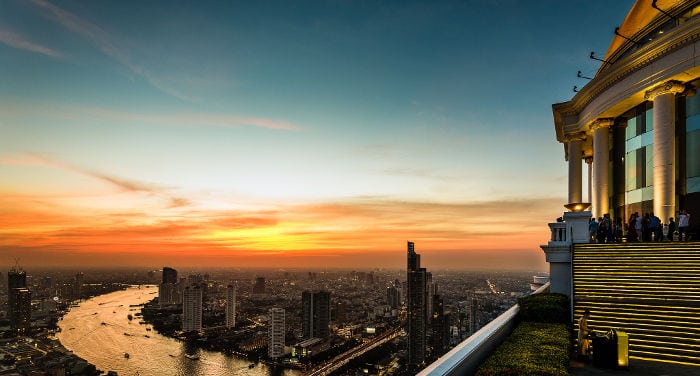
The complete name of Bangkok is composed of more than twenty words, which when translated mean “City of angels, the great city, the city of eternal joy, the impenetrable city of the god Indra, the magnificent capital of the world adorned in precious gems, the happy city that abounds in the colossal Royal Palace, which is like the divine home where the reincarnated gods reign, a city blessed by Indra and built for Vishnukam”.
Bangkok, the largest and most populated metropolis of Southeast Asia with its almost 10 million inhabitants, is climbing the toward the top of the list of the most extensive and busiest cities on the planet.
Located on the banks of the Chao Praya River, up until 1782 Bangkok was like any other town. Since then, thanks also to the fact that King Rama I made it the capital of Siam, it began its commercial, political and diplomatic climb.
Click on one of the following links to jump directly to the section of the article that interests you most:
Traveling to Bangkok – Index
How to get to Bangkok
As an important gateway for many people, both tourists, businessmen or travelers in transit toward another country, Suvarnabhumi airport in Bangkok is one of the busiest in the world.
From the third floor of the airport planes leave toward all the world capitals, including North Korea.
Landing in Bangkok from almost any European capital is possible practically every day and (almost!) every hour. Most direct flights to Thailand are offered by Thai Airways.
If you’re looking for an alternative to the Thai national carrier, I recommend that you look at airlines such as Emirates, Qatar, Etihad, and also the Russian Aeroflot or British Airways.
Before 2006, the city’s only airport (in the northern part near the border of Pathum Thani) was Don Muang. Once Suvarnabhumi was inaugurated, however, Don Muang Airport is used only for domestic lights and as a hub for low-cost carriers such as Air Asia or Nok Air, which offer international flights mainly in Asia (including Australia and, in a few months, the Hawaiian Islands).
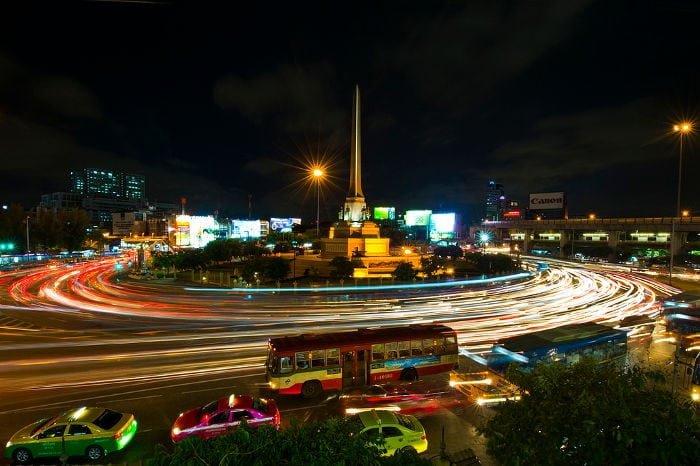
What to do upon arriving in Bangkok
Upon landing, you need to head toward the terminal exit to get your bags, but before that, you’re required to pass through the immigration office.
You have to fill out a form (which will already have been given to you on the plane) where you’ll have to provide some personal information: how much you earn annually if this is your first time in Thailand, what hotel you’ll be staying in, your phone number, etc.
Once you hand this form over to the document, they’ll take a picture of you and stamp your passport with your date of entry into the country.
Note that if you’re vacationing in Thailand for less than 30 days, your passport is valid for at least six months issued by one of the countries on this list (US, UK, Canada, Australia, and most European countries are on it) and an onward ticket leaving the country (within 30 days of your date of arrival), then you won’t need a visa.
Here you’ll find our complete guide on visas for Thailand.
Arrivals are on the second floor of the airport and once you leave the immigration office and get your bags you have two choices: take a taxi right from the second floor or go down to the first floor below ground (-1) and take the train that will bring you to the middle of the city from the airport.
Inaugurated in 2011, the trip goes from the BTS station of Phaya Thai right into the middle of the airport, it’s very popular with foreign tourists that don’t want to take a taxi and wait for hours and hours in Bangkok traffic.
The price of a ticket from the airport to the Phaya Thai station is 45 THB a person, and the travel time is 28 minutes exactly. The Airport Rail Link trains, run from 6:05 in the morning until midnight, with another train about every 15 minutes.
If you opt for the taxi instead, make sure that “taxi meter” is written on the car, and that they’re official taxis and not illegal ones, which often happens.
Official taxis are usually green, pink, yellow, blue, and rarely red. Before getting into the car make sure that the driver uses the meter so that you pay according to the time of your trip.
The majority of the time, especially in airports where unaware tourists can’t wait to get to their hotel and have no idea of what the service costs, they’re charged astronomical prices for trips that usually cost between 300 to 400 THB a car.
An important fact to remember is that the tolls on the highways are your responsibility; it’s a very low fee that goes for a maximum of 70 THB.
Another detail to not forget before leaving is to print or write on your phone the address of the hotel you’re staying at so as to show it to the taxi driver.
As an enormous city, it’s normal that drivers don’t know where every hotel is located, especially if it’s a little-known guest house or hostel. So always bring along the address of your lodging in the Thai language.
This little trick will save you the trouble of explaining to the driver where to go (likely you won’t know how to direct him either if it’s your first trip to the city), since many don’t speak English and even less can read an address that isn’t written in Thai.
If the address isn’t enough, write the telephone number of the hotel as well so that the driver can call the reception and find out where to leave you.
When to visit Bangkok
Since it is so big and full of things and places to see and do, you can visit the city any time of year. As a city that also has a tropical climate, it is hit by monsoons in the month of April until the end of October-mid November.
Unlike the country’s islands, however, the downpours in the city usually last for just a few hours, and it normally rains in the evening or during the night.
Not having an efficient sewer plant, during the rainy season, the city’s streets become impassable and the water can even reach heights higher than half a meter.
It, therefore, becomes difficult to get around, especially in places where there’s no Skytrain line since taxi drivers will charge you 500 THB for going only 200 meters.
So I recommend that you visit Bangkok during the dry season, from November to the end of March, when temperatures stay at around 28-32 degrees without too much humidity.
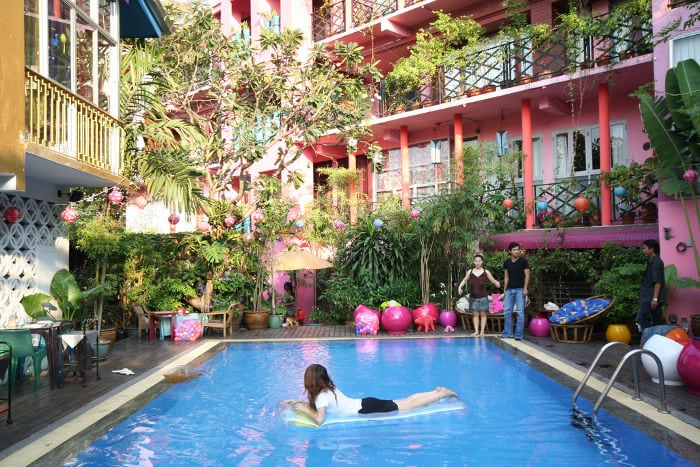
Where to stay in Bangkok
In Bangkok, you will find any category of hotel you can imagine. It goes from shared-room hostels mainly located on Khao San Road, to five star hotels located mainly between Silom, Siam, and Sukhumvit.
Click here to read our reviews on the best hotels in Bangkok.
Sathorn, Silom and Sukhumvit
If your budget and expectations regarding comfort are high, then I recommend that you look for a hotel in the Sathorn area, where you’ll find the famous Lebua Hotel (5,000 THB a night), a five-star hotel known for its bar located on the last floor of the building, where a part of the movie “Hangover 2” was filmed.
In Silom there’s a five star hotel that directly faces Lumpini Park, the So Sofitel (6,500 THB).
Also along the Sukhumvit line you’ll find excellent buildings, particularly in luxury areas like Asoke, Pron Pong, Thonglor, and Ekkamai. In these areas you’ll have an abundance of choice, ranging from the Marriott (5,500 THB) to the Hilton (7,000 THB).
Victory Monument
If you’re looking for a mid-range hotel that isn’t too far out of the center and gives you the opportunity to come into contact with the local customs, then Victory Monument is right for you.
Personally, it’s an area that I prefer. Though located just two kilometers from the Central World shopping center (so right in the center), Victory Monument is an area that offers you cheap shopping venues, delicious Thai restaurants where you can try foods from all over the country (including the extremely spicy food from the northeast, called Isaan food), and a green area where you can relax and drink from a coconut while reading a book: Santiphap Park, or Peace Park.
The majority of hotels are located on a road known for its wide gamut of Thai food on offer, especially for the little restaurants but also for the street vendors: Soi Rang Nam.
A new hotel located a few steps from Peace Park is Picnic Hotel, which finished construction in 2015, with double rooms from 2,000 THB a night.
An alternative is Bizotel (2,000 THB). Also located on Soi Rang Nam, the building also offers a delicious restaurant on the first floor where in the evening they have happy hours (two drinks for the price of one).
Hostels: Khao San Road and Phaya Thai
Hostels in Thailand are generally clean and safe. Rooms can vary in size from 4 people up to 12 and more. Prices start from 300 THB a night, depending on the comfort and location of the hostel. For this type of lodging, the most popular area is Khao San Road, for its low-cost hostels and restaurants.
Khao San Road is a street located in the old area of the city (southeast of the center, represented by Siam), adjacent to the historic center and monuments such as the Gold Mountain and Royal Palace.
Personally, I’d recommend this area for those touring on a limited budget. This area of the city is charming, close enough to many places of interest to tourists. Restaurants offer Thai food at rock bottom prices, and there’s an ample selection of vegetarian restaurants like May Kadee and Ethos.
During the evening Khao San Road transforms into a street full of life. Bars serve alcoholic beverages of all sorts and you can also find a few clubs that serve as little discos open until late into the night.
What I find a little inconvenient about this area is the fact that it’s not connected to public transport such as the metro (the closest stop is Hua Lamphong) or the BTS.
An alternative to Khao San Road, again speaking of hostels, is the Phaya Thai area (north of Siam, two Skytrain stops from the center). Prices are slightly higher, but the comfort level that hostels can offer (such as single rooms with private safe, included breakfast, and a pool on the roof) is higher. Some hostels I’d recommend are the In a Box Hostel (1,200 THB a night) and the Restiny Hostel (1,200 THB).
From this area, you can easily reach any part of the city as well as the airport thanks to the vicinity of the Skytrain.
Click here to read our reviews on the best hotels in Bangkok.
How to get around Bangkok
The city’s public transport options (read our article “How to get around Bangkok” for details) are many and inexpensive:
Bus
Buses cover the entire urban network of the city and some also go to nearby cities, like Pattaya or Kanchanaburi. Buses are an extremely cheap way of getting around the center (tickets start from 6.50 THB) if you have the patience and disposition, considering the terrible traffic that afflicts the city in peak hours.
Minivans
In my opinion, minivans are a little dangerous both for the high speeds at which they travel and the reckless drivers, leading to a high level of mortal accidents in which Thailand holds the top spot.
When it comes to price they are very convenient but aren’t so comfortable for traveling with kids or large bags. Minivans mainly cover the suburban areas of the city, heading into nearby provinces such as Pathum Thani, for example.
Skytrain
The Skytrain (Bangkok Transit System, commonly called BTS) is an elevated train that is very convenient though not too cheap. The Skytrain covers the north, west, and south of the capital, at a length of about 30 kilometers.
All runs start at a base price of 15 THB (for one, maximum of two stops), going up to 52 THB for longer trips. During peak hours it is mobbed by commuters from all over the city, but still remains a very fast and efficient way of getting around, especially if you’re looking to travel along Sukhumvit Road.
Metro (MRT)
The Metro, or MRT, offers just one line – the blue line, – which covers the northwest of the city, going as far as Sukhumvit then heading to the Hua Lamphong train station.
Prices are less than the Skytrain, but rather expensive compared to the bus. Both the metro and the Skytrain only run during the day. At night they are substituted by buses.
Train
Hua Lamphong station offers train that connect the capital to many Thai cities. The most famous and popular trip for tourists is the one that links Bangkok to the city of Chiang Mai. Available routes aren’t limited just to Thailand but also go to bordering countries such as Laos and Cambodia.
Airport Link Train
Built in the last decade, this line offers a connection from the city center (Phaya Thai) to Suvarnabhumi airport, in less than a half-hour for a price of 45 THB.
Boat
Like buses, boats to are a very convenient mode of transport. Not often used by tourists, unless navigating the Chao Phraya River from the Saphan Taksin stop up to Wat Arun and the Royal Palace, boats in the capital navigate kilometers and kilometers of canals, going as far as the peripheral zones of the city.
Taxi, Tuk-tuks, and Mototaxis
The most expensive way to get around is the tuk-tuks and moto-taxis. Taxis are instead comfortable and convenient and sometimes you can also find nice drivers with whom you can chat.
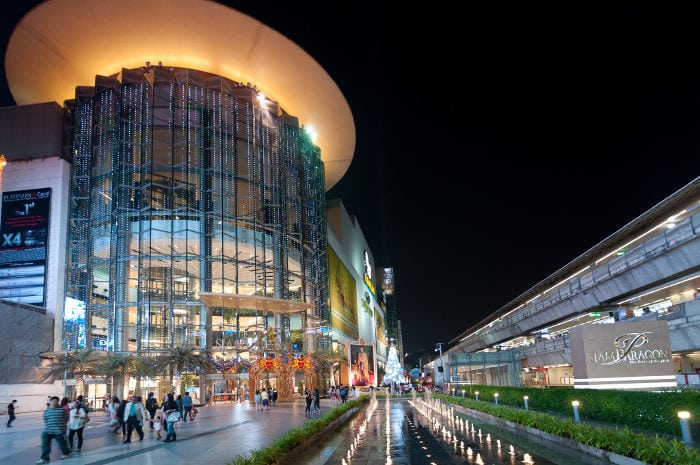
The districts of Bangkok
The city of angels is subdivided into 50 districts called “khet”, which in turn are subdivided into under-districts called “khwaeng”.
The ancient historic center (Rattanakosin), the place where even today there’s the largest concentration of temples, the Royal Palace, and the famous Khao San Road, is located in the western part of the city.
To the east of the historic center, we find the Chinese quarter (Yaowarat). Quite active in commercial terms, Chinatown is quickly evolving when it comes to restaurants and stylish clubs. Easily reachable from the Hua Lamphong metro station, this part of the city isn’t served by the Skytrain, but only buses, taxis, and tuk-tuks.
South of Chinatown is the beating heart of the city’s economy, represented by the neighborhoods of Silom and Sathorn. Characterized by skyscrapers, five-star hotels (like the So Sofitel), and the green lung of the city (Lumpini Park), these two neighborhoods are the center of nightlife and popular clubs like Maggie Choo’s.
Since the construction of the first paved road in 1861, Silom and Sathorn have slowly become real urban agglomerations, thanks too to the construction of the elevated urban rail line, the so-called Skytrain, or as it’s commonly called by anyone who has lived in Bangkok, BTS.
Just north of Silom and Sathorn, we find what today represents the center of the city: Siam. In this part of the city rise the three largest malls in all of Thailand, namely the Siam Paragon, the MBK center and Central World (the biggest of all).
South of Silom, on the opposite bank of the Chao Praya River, there’s the neighborhood of Thonburi, especially famous for hosting the Temple of the Sunrise, Wat Arun. This region isn’t particularly developed or interesting from a tourist’s point of view, as it’s mainly a residential area.
The Skytrain connects the Siam neighborhood with the western, northern, and southern areas of the city. To the west is Sukhumvit, the longest road in the world, which starts in Bangkok going all the way to Pattaya. It is along this road in which the majority of foreign residents in Bangkok live.
To the north Phaholyotin Road stretches out (often also written as Phahoyotin or Pahonyotin), a long road kilometers long that starts at the roundabout at Victory Monument going all the way to the province of Pathum Thani.
In this part of the city there are neighborhoods like Phaya Thai, Victory Monument, Sanam Pao, Ari, Saphan Kwai, and Mo Chit.
This is a less touristy area compared to Sukhumvit, but just as beautiful and interesting, especially if you want to experience the daily life of the Thai people.
Victory Monument, in particular, is a lively and inexpensive area, well connected to the rest of the city since it is home of the station where all buses leave to the center and beyond.
Mo Chit instead is famous for its weekend market: Chatuchak Market. This enormous market is held every Saturday and Sunday and inside is home to more than 8,000 stalls where you can find everything, from things for the home to “domestic” animals such as sharks and monkeys.
In the northeast of the city, you’ll find the political center, Dusit. This neighborhood is easily reachable on foot from Victory Monument, or by bus since it isn’t served by any lines of the Sky Train. Its main characteristic is its large green spaces, like Dusit Palace, a complex of royal residences belonging to King Rama V.
Between the northern zone and Sukhumvit, in the neighborhood of Ratchadaphisek, known mainly for its road full of discos and pubs: Royal City Avenue (commonly called RCA). This area doesn’t offer practically anything for tourists, but is mainly populated by condominiums and scholastic institutions, like the Thai Sandee School.
The RCA area, and Ratchadaphisek in general, aren’t very well connected with the rest of the city; there’s a metro stop a few kilometers away and the line that goes from the city center as far as the airport, the Airport Rail Link.
Despite the high number of neighborhoods (in turn dividable into 12 under-districts), the city’s regions are grouped into just 12 areas: Mathasawat, Sanam Chai, Taksin, Thonburi, Burapha (including part of Sukhumvit), Chao Phraya (which is includes areas like Chinatown and Sathorn), Lumphini (which also includes the Silom area), Phra Nakhon Nuea, Rattanakosin, Sinakharin, Suwinthawong, and Vibhavadi, which is also home to the majority of neighborhoods located in the northern part of the city, like Ari and Mo Chit.
The areas illustrated in this section are the most central and most visited both by tourists and foreign residents of the city who for one reason or another move between the various sections of Bangkok.
Zones like Phra Nakhon Nuea or Suwinthawong, are periphery areas up to 15 kilometers outside of the city, such as the area around Suvarnabhumi airport.
Safety in Bangkok
First of all, before traveling to Thailand, and in Asia in general, I recommend that you take out a health insurance policy.
Despite being considered one of the safest cities in the world and all of southeast Asia, I recommend that you adopt a responsible and attentive way of behavior, especially in the evening.
The Thai people and Asians, in general, have a calm and gentle demeanor. However pay special attention when negotiating prices for taxis and tuk-tuks, don’t raise your voice or take a vulgar or threatening attitude, otherwise, you might be taking a huge risk, since Bangkok’s taxi drivers are famous for being ex muay Thai fighters, and not putting up too much with foreigners (whom they call “Farang or Falang”).
Besides the obvious advice to not walk around with valuable items in full view, like jewelry, I recommend you keep backpacks and purses close to your body and avoid leaving them dangling unattended on your back where they can be cut and stolen, as has happened to some tourists, especially in the area around China Town.
Try to carry as little cash as possible; credit cards are accepted everywhere. Always bring a copy of your passport with you so that you can prove your identity and clearly and legibly show your visa.
Tuk-tuks and moto-taxis can be an entertaining experience, especially if you’ve never been to Asia, but make sure that they give you a helmet when you get onto a moto, and don’t abuse them since they aren’t the safest means of getting around.
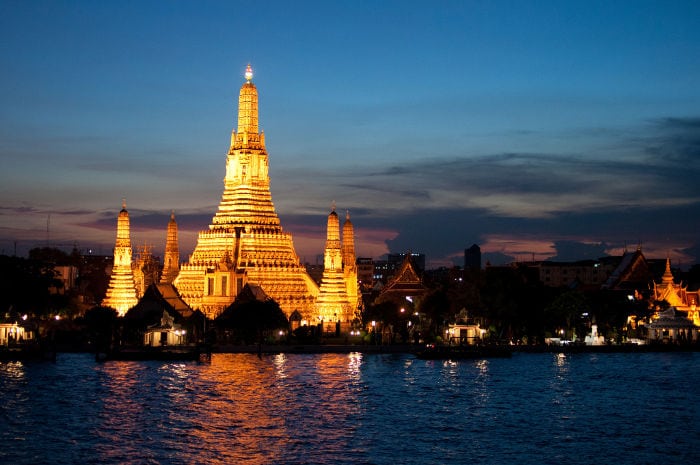
What to see in Bangkok
Old city
The area that offers the biggest attractions when it comes to temples Thai architecture, is the old city. Located along the banks of the Chao Phraya, this neighborhood was considered Bangkok’s original center, during the XIX century.
In this area, there are several attractions to visit. The top one, in my opinion, is the Temple of Sunrise (Wat Arun in Thai), a gorgeous temple in Khmer style located on the shores of the Chao Phraya River, which during the XIX century represented the tallest building of the city.
You can get to Wat Arun by taxi, but an alternative itinerary is to take a boat from 40 THB that leaves from the port of Saphan Taksin every half hour.
Get off at the stop located on the opposite shore of the temple, and from there take another boat (a smaller one) for 3 THB, which brings you to the entrance of Wat Arun.
You can visit the gardens for free, if you’d rather “climb” the temple and have a 360° view of Bangkok, then you’ll have to pay 100 THB.
After seeing Wat Arun you can take the same boat and return to the west bank of the river. From here you can easily reach Wat Pho, the Temple of the Reclining Buddha on foot.
Tickets cost 150 THB a person and include a little bottle of water. The temple houses a massive golden reclining Buddha a good 46 meters long.
The majority of tourists go into seeing the reclining Buddha then move on. I recommend that you also take a tour of the other Buddhist complexes present. One example is the oldest school of Thai massage in the country.
The history of the reclining Buddha and its name (in Thai: Wat Phra Chetuphon Wimon Mangkhlaram Ratchaworamahawihan, but abbreviated as Wat Pho) go back to the time of the Kingdom of Siam, when the city of Ayutthaya was still the capital of the Kingdom of Thailand.
The legend says that the Buddha lived in India, in a temple also called Wat Pho. To pay homage to the Buddha it was decided to build a statue in his honor in the ancient capital of Ayutthaya, which unfortunately was destroyed during the war between the Burmese and Thais. So King Rama I decided to make a replica in Bangkok.
The Royal Palace is one of the monuments with the highest entrance fees: 500 THB. Personally, I don’t find this attraction terribly interesting, and certainly not the 500 THB they make you pay (just for foreigners, Thais enter for free).
Inside the palace, you can visit a museum on the ancient weapons of the Thai army, as well as golden thrones where all previous kings sat, including the beloved King Bhumibol, who died in November 2016.
One of the most precious objects, located in the only wing of the palace where you can’t take photos, is the statue of the Emerald Buddha.
To the east of the royal palace, you’ll find the Golden Mountain (Wat Saket). This complex of temples is today one of the most important Buddhist schools in Thailand.
As you can guess from the name, the Golden Mountain is a temple located on the top of a small hill, reachable via a long staircase. The temple itself isn’t a big deal, the best part is the view you can enjoy from the top.
Up until last year, the Golden Mountain could be visited for free, now though there’s a fixed price of 50 THB a person.
Remember that for all four locations you’ll be required to wear appropriate clothing, so no uncovered shoulders or shorts (for men too).
Before going into any temple you’ll have to take off your shoes, and remember that if you want to sit down you should never point your feet in the direction of the Buddha, nor turn your back on it.
To the west of the old city is the Chinese quarter. The Chinatown in Bangkok is one of the ugliest (and in some corners, dangerous) that I’ve ever seen. Other than the main road and a few Chinese temples (like Wat Traimit), there isn’t much to see. As an area, it’s very dirty and not well connected with the rest of the city.
Attached to Chinatown there’s the Indian neighborhood (Little India), though even in this case it’s nothing special. You’ll see a few stalls selling pashminas in an Indian style or spices of various types.
Siam
The new center of Bangkok is Siam. It’s a neighborhood where the old and new blend perfectly together.
Siam is especially known among tourists for its enormous shopping malls offering everything: banks, restaurants, clothing and food stores, cinemas, aquariums, museums, and even cosmetic clinics.
The three most famous shopping malls are the Siam Paragon (which also includes the Siam Center), MBK, and Central World. Right near this last one (and 2 kilometers from Victory Monument), is another market, much less upscale but just as popular among tourists and locals: the Pratunam Market.
The Pratunam market is a typical Thai market where you’ll find merchandise of various types like souvenirs, bags, suits, and much more at low prices. The quality of the merchandise for sale is definitely not the same as found in the malls like Siam or Central World but looks more like the articles for sale at MBK. There’s often clothing, bags, or scarves sold in large quantities, suitable for those who have clothing shops.
If you’re not all that into shopping malls, in the same area you can visit the House of Jim Thompson, a wooden house in pure Thai style.
Built in 1958, on a piece of land directly facing the canal, this house museum belonged to an American silk merchant Jim Thompson.
Thompson was also a great collector of art from throughout Southeast Asia, and after his mysterious disappearance in 1967, his house was changed into a museum.
Today you can visit it for 150 THB, from 9:00 to 18:00. Upon entering you can choose the language of your tour: English, French or Spanish.
You’ll be asked to remove your shoes to visit the house and will be accompanied by a guide for about 30 minutes.
Morchit
The biggest market in all of Thailand is Chatuchak Market. It’s open only on the weekend from 6 in the morning to 6:00 in the evening. To get there you can take the Skytrain in the direction of Mo Chit, get off at the top of the same name, and follow the enormous mass of people there every weekend. You can’t go wrong!
Inside the market, there are more than 8,000 stalls, and you’ll find everything, including restaurants where you can try local food.
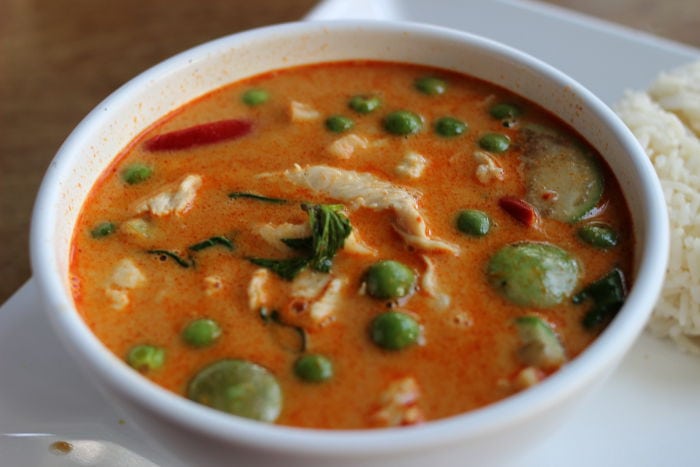
Where to eat in Bangkok
Thai
You can’t come to Thai without trying the local food. There are many dishes in Thai cuisine that can vary widely depending on the region where it comes from. In this section, I’ll discuss the three most famous ones.
The first dish is Pad Thai, the Thai version of spaghetti. This dish is made of rice noodles cooked with vegetables, meat or fish, an egg, and a condiment made of soy sauce, nuts, spicy oil, soy sprouts, and sugar.
The absolute best place to eat Pad Thai in Bangkok is the restaurant Tip Samai. This family restaurant has been around for more than 100 years and is quite famous among the inhabitants of Bangkok, so much so that every evening there’s a really long line of people waiting for a table.
The particularity of this restaurant is that the kitchen is on the sidewalk, while the tables are inside. Considering the large number of customers the restaurant has every evening, they’ve also set up tables on the sidewalk where you can admire the Thai chefs cooking Pad Thai on wood.
The Tip Samai offers only Pad Thai (not even drinks!),for prices starting at 70 THB a plate.
The second dish is papaya salad, which is very light and spicy. The original recipe comes from the north of the country (famous for its spicy cuisine).
The dish is made of finely cut green papaya, seasoned with roasted peanuts, tomatoes, limes, fish sauce, shrimp, garlic, green string beans, and sugar.
The best place to taste it in different forms is located near Victory Monument, in Soi Rang Nam, and is called Tida Isaan. This too is a family restaurant and prices are very low; the price for a papaya salad starts at 30 THB.
Tom Yam is a soup made with fresh greens like lemongrass and galanga, a drop of lime, prepared with red, green or yellow curry depending on the type, and the inevitable spicy pepper.
Other ingredients are added like meat or fish depending on your taste. An excellent variety is made with the addition of coconut milk.
The best Tom Yam that I’ve eaten in Bangkok is the coconut milk version made at B Resto, also located on Soi Rang Nam. If you want to try it in vegetarian style I recommend instead the restaurant May Kadee’s, on Khao San Road.
Pizza, pasta, and more
Foreign restaurants are located, with few exceptions, on Sukhumvit Road.
Here you’ll find Japanese, Chinese, Korean, Mexican, Spanish, German, Greek, Indian, Swiss, or Argentinian restaurants, even classic Italian pizzerias.
Japanese restaurants, especially those that serve sushi, are usually part of chains like Fuji, which are nothing like the taste of real Japanese cuisine. You can find an authentic Japanese restaurant near the BTS at Asoke, Soi 24.
Unfortunately, the restaurant’s name is written only in Japanese characters and has no internet site; it’s very easy to find it though. As soon as you get off at BTS Asoke, by Terminal 21, go to the left on road number 24 and go straight until you see a Spanish restaurant called Barcelona Gaudì. At this point go straight for 200 meters, and on your right, you’ll find this exquisite restaurant. You can’t miss it since it’s the only Japanese restaurant on the block.
In the Nana section, at soi numero 11, you’ll find a road full of Spanish, Indian, Mexican, German, and African restaurants.
Among the best Italian restaurants in the area is Sfizio, a little restaurant located on the same road as the shopping center “Terminal 21”, run by two young Italian guys.
Another excellent choice is Bacco, at Tong Lhor. It has an extensive menu and the restaurant also has great prosciutto.
Nightlife in Bangkok
The area with the wildest discos and parties is Royal City Avenue. On this kilometer-long road, you’ll find bars and discos open until late at night. All discos have entrance fees that start at 300 THB, and you’ll be required to dress appropriately, namely closed shoes and long pants (for men).
On Sukhumvit, there are lots of opportunities to have a cocktail, drink a beer, or listen to music until late into the night. A club that I like a lot is the Iron Fairies, located at Thonglor.
I recommend that you visit this pub Monday nights when it’s karaoke night and whoever wants to can perform a song accompanied by a live band. It has a good selection of wines and beers, but lousy and expensive food.
In the same neighborhood, there’s also Wanderlust, a club located on the roof of a four-story building where you can eat ribs and listen to live music.
In the Victory Monument area, there’s a club where different live bands play mostly jazz and reggae, called the Saxophone. A cool place to go after dinner, especially on Friday nights when bands like T-Bone play, but I don’t recommend that you eat dinner there; the food is nothing special.
In the south of the city, there are several skyscrapers like the So Sofitel and the Lebua, which on the top floor (respectively the 24th and 63rd) offer breathtaking views, especially at night when the city of angels lights up in many shades of color, creating a unique atmosphere.
Frequently asked questions
In the evenings, a regular shirt or t-shirt with either shorts or pants works fine. Keep in mind that some high-end bars and sky bars require that you wear pants. So Check it in advance.
According to aqicn, the air quality has a PPM of 82 micrograms which is considered “Moderate” and on par with Shenzhen.
Photo Credits: ![]() Reflections Hotel, Bangkok by fuzheado
Reflections Hotel, Bangkok by fuzheado
![]() Siam Paragon by Mark Fischer
Siam Paragon by Mark Fischer
![]() Wat Arun at Dusk by Mark Fischer
Wat Arun at Dusk by Mark Fischer
![]() Around & Around we Go by Mike Behnken
Around & Around we Go by Mike Behnken
![]() The Dome (Sky Bar), Bangkok by Tore Bustad
The Dome (Sky Bar), Bangkok by Tore Bustad

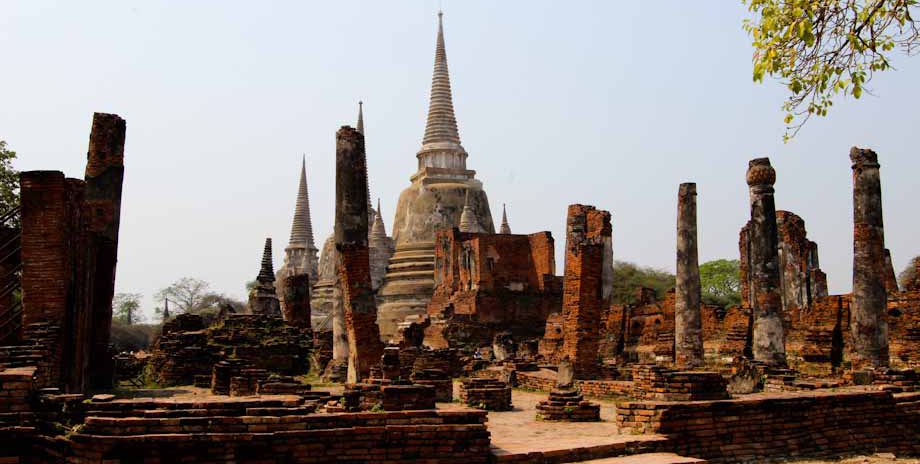
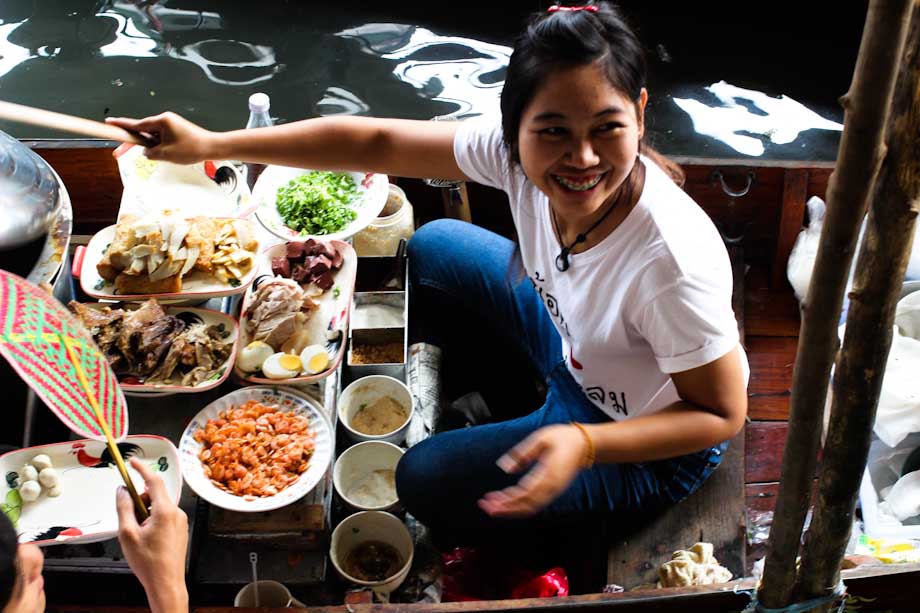

One comment regarding Khao San Road being disconnected. Walk down to the river (a few minutes walk) and take the ferry, which will drop you directly at the beginning of the Sky Train. You are connected to the Sky Train from that area ! The stop to get on is just past The Grand Palace. Wont cost more than 10 cents for the ferry.
Hi Hilary thank you for the tip : )